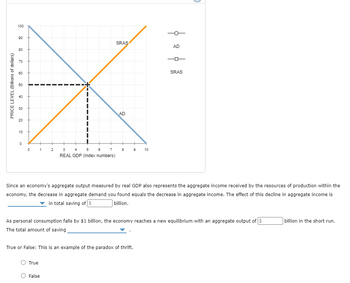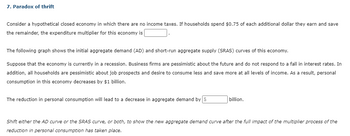
ENGR.ECONOMIC ANALYSIS
14th Edition
ISBN: 9780190931919
Author: NEWNAN
Publisher: Oxford University Press
expand_more
expand_more
format_list_bulleted
Question
1st drop down = increase/decrease
2nd drop down = increases/remains unchanged/decreases

Transcribed Image Text:PRICE LEVEL (Billions of dollars)
100
90
80
70
60
50
40
30
20
10
0
0 1
2
3 4
5
7
REAL GDP (Index numbers)
True
6
False
SRAS
AD
8
9 10
Since an economy's aggregate output measured by real GDP also represents the aggregate income received by the resources of production within the
economy, the decrease in aggregate demand you found equals the decrease in aggregate income. The effect of this decline in aggregate income is
in total saving of $
billion.
True or False: This is an example of the paradox of thrift.
AD
As personal consumption falls by $1 billion, the economy reaches a new equilibrium with an aggregate output of $
The total amount of saving
SRAS
billion in the short run.

Transcribed Image Text:7. Paradox of thrift
Consider a hypothetical closed economy in which there are no income taxes. If households spend $0.75 of each additional dollar they earn and save
the remainder, the expenditure multiplier for this economy is
The following graph shows the initial aggregate demand (AD) and short-run aggregate supply (SRAS) curves of this economy.
Suppose that the economy is currently in a recession. Business firms are pessimistic about the future and do not respond to a fall in interest rates. In
addition, all households are pessimistic about job prospects and desire to consume less and save more at all levels of income. As a result, personal
consumption in this economy decreases by $1 billion.
The reduction in personal consumption will lead to a decrease in aggregate demand by $
billion.
Shift either the AD curve or the SRAS curve, or both, to show the new aggregate demand curve after the full impact of the multiplier process of the
reduction in personal consumption has taken place.
Expert Solution
This question has been solved!
Explore an expertly crafted, step-by-step solution for a thorough understanding of key concepts.
Step by stepSolved in 4 steps with 4 images

Knowledge Booster
Learn more about
Need a deep-dive on the concept behind this application? Look no further. Learn more about this topic, economics and related others by exploring similar questions and additional content below.Similar questions
- Give two examples of goods or services that you have seen inflate dramatically and also deflate dramatically over the past few years.arrow_forwardAggregate Variables Value (in billions of dollars) in the base year Consumption spending $900 Investment spending $400 Government spending $200 Transfer payments $60 The marginal propensity to save is equal to 0.4 and there are no exports or imports, (a) Calculate the real GDP in this country, Show your work (b) Calculate the marginal propensity to consume Show your work. (c) Suppose that the government increases spending from $200 billion to $300 billion (i) Calculate the maximum change in real GDP. Show your work (ii) Given the change in real GDP in part (c)(i), calculate the maximum level of the new equilibrium real GDP. Show your work (d) Suppose that taxes decrease by $100 billion. Will the maximum change in real GDP be larger than, smaller than, or equal to the change in part (c)(i)? Explain.arrow_forwardThe equilibrium level of real GDP is Real GDP Consumption (Y) (C) $8,000 $6,200 9,000 10,000 11,000 12,000 6,850 7,500 8,150 8,800 Planned. Gov't Net Investment Purchases Exports Aggregate Planned (1) $1,675 (G) (NX) $1,675 -$500 Expenditure $9,050 1,675 1,675 -$500 9,700 1,675 1,675 -$500 1,675 -$500 1,675 -$500 1,675 1,675 10,350 11,000 11,650 Unplanned Change in Inventories $-1,050 -700 -350 350arrow_forward
- Generally, as the proportion of middle-income households in a country __________, the __________ a nation's purchasing power tends to be. A. increases; greater B. increases; less C. decreases; greater D. decreases; less E. There is no relationship at allarrow_forwardDuring the Covid-19 recession, from the fourth quarter of 2019 to the fourth quarter of 2020, consumer spending on residential construction ________ and consumer spending on services ________. Part 2 A. declined by 20 percent; increased by 20 percent B. increased by 5 percent; increased by 10 percent C. increased by 20 percent; declined by 5 percent D. declined by 25 percent; declined by 40 percentarrow_forwardQuèstion 4 "As disposable income increases, consumption:" O And saving both increase. O Decreases and saving increases. O And saving both decrease. O Increases and saving decreases.arrow_forward
- Consumption Function) How would an increase in each of the following affect the consumption function? a. Consumers’ net wealth b. The price level c. Disposable incomearrow_forwardReal Disp. Consmp. Income Spending Saving Invst Plnd Plnd Govt Net Plnd Exp. Export Exp. 10.8 GDP Tax 10 6.8 1.2 1.5 2 0.5 11 7.6 1.4 1.5 0.5 11.6 12 10 8.4 1.6 1.5 2 0.5 12.4 13 2 11 9.2 1.8 1.5 2 0.5 13.2 14 12 10.0 2.0 1.5 0.5 14.0 15 13 10.8 2.2 1.5 0.5 148 16 14 11.6 2.4 1.5 2 0.5 15.6 Note: Amounts in billions. Refer to the above table. The equilibrium real GDP is $15 billion. $14 billion. $13 billion. $12 billion.arrow_forward1. Complete this chart. ***Remember, you are looking at the change in income and spending. ( Income $20,000 $40,000 $60,000 $80,000 Expenditures MPC N/A $11,000 $25,000 $35,000 $41,000 MPS N/Aarrow_forward
- Corn (lb) Scarves(#)U.S. 20 10Mexico 25 5 If the multiplier is 4 and a change in government spending leads to a cumulative $500 million decrease in aggregate spending, then initially: a. Government spending decreased by $125 million. b. Government spending decreased by $500 million. c. Taxes decreased by $100 million. d. Government spending decreased by $100 million.arrow_forwardIn the equation S = 130 – 2T, where S is hot chocolate sales and T is temperature, sales _____ if temperature increases by 10 degrees. A. increase by 20 B. decrease by 20 C. increase by 2 D. decrease by 2arrow_forward1. If "Apparent Consumption" is adjusted with captive consumption and effect of abnormal factors, one arrives at a. Minimum Consumption b. Maximum Demand c. Optimum consumption d. Effective Demand 2. What is the Price elasticity if Quantities demanded and Price levels of the Base year and following year are respectively 10000 and 9000 (Quantities) and 600 and 800 (Price levels) a. -0.02 b. -0.37 c. -1.14 d. None of the options 3. Which of the following is a method used for EIA a. Regression analysis b. Pay back period c. Seismological survey d. Computer aided EIA 4. Among the list given below which one indicates the difference in the Nature of Equity and Debt a. Claim on the Firm-residual wealth, vs. Principal and dues b. Payment/Returns-Dividend vs. Interest c. Tax treatment- post tax disbursement vs. a charge to profit d. All of the optionsarrow_forward
arrow_back_ios
SEE MORE QUESTIONS
arrow_forward_ios
Recommended textbooks for you

 Principles of Economics (12th Edition)EconomicsISBN:9780134078779Author:Karl E. Case, Ray C. Fair, Sharon E. OsterPublisher:PEARSON
Principles of Economics (12th Edition)EconomicsISBN:9780134078779Author:Karl E. Case, Ray C. Fair, Sharon E. OsterPublisher:PEARSON Engineering Economy (17th Edition)EconomicsISBN:9780134870069Author:William G. Sullivan, Elin M. Wicks, C. Patrick KoellingPublisher:PEARSON
Engineering Economy (17th Edition)EconomicsISBN:9780134870069Author:William G. Sullivan, Elin M. Wicks, C. Patrick KoellingPublisher:PEARSON Principles of Economics (MindTap Course List)EconomicsISBN:9781305585126Author:N. Gregory MankiwPublisher:Cengage Learning
Principles of Economics (MindTap Course List)EconomicsISBN:9781305585126Author:N. Gregory MankiwPublisher:Cengage Learning Managerial Economics: A Problem Solving ApproachEconomicsISBN:9781337106665Author:Luke M. Froeb, Brian T. McCann, Michael R. Ward, Mike ShorPublisher:Cengage Learning
Managerial Economics: A Problem Solving ApproachEconomicsISBN:9781337106665Author:Luke M. Froeb, Brian T. McCann, Michael R. Ward, Mike ShorPublisher:Cengage Learning Managerial Economics & Business Strategy (Mcgraw-...EconomicsISBN:9781259290619Author:Michael Baye, Jeff PrincePublisher:McGraw-Hill Education
Managerial Economics & Business Strategy (Mcgraw-...EconomicsISBN:9781259290619Author:Michael Baye, Jeff PrincePublisher:McGraw-Hill Education


Principles of Economics (12th Edition)
Economics
ISBN:9780134078779
Author:Karl E. Case, Ray C. Fair, Sharon E. Oster
Publisher:PEARSON

Engineering Economy (17th Edition)
Economics
ISBN:9780134870069
Author:William G. Sullivan, Elin M. Wicks, C. Patrick Koelling
Publisher:PEARSON

Principles of Economics (MindTap Course List)
Economics
ISBN:9781305585126
Author:N. Gregory Mankiw
Publisher:Cengage Learning

Managerial Economics: A Problem Solving Approach
Economics
ISBN:9781337106665
Author:Luke M. Froeb, Brian T. McCann, Michael R. Ward, Mike Shor
Publisher:Cengage Learning

Managerial Economics & Business Strategy (Mcgraw-...
Economics
ISBN:9781259290619
Author:Michael Baye, Jeff Prince
Publisher:McGraw-Hill Education